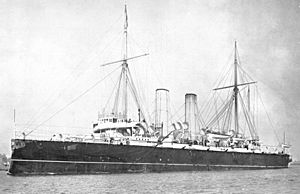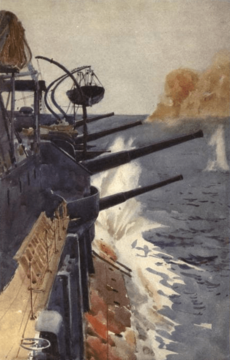HMS Theseus (1892) facts for kids
HMS Theseus was a special kind of warship called a protected cruiser in the Royal Navy, which is the British navy. She was part of the Edgar class of ships, which were a bit like the Blake class but smaller. Theseus was built in Leamouth, London, and was launched in 1892. She officially joined the navy on January 14, 1896.
 |
|
Quick facts for kids History |
|
|---|---|
| Name | HMS Theseus |
| Namesake | Theseus |
| Builder | Thames Ironworks and Shipbuilding Company |
| Laid down | 16 July 1890 |
| Launched | 8 September 1892 |
| Commissioned | 14 January 1896 |
| Fate | Sold for breaking up 8 November 1921 |
| General characteristics | |
| Class and type | Edgar-class cruiser |
| Displacement | 7,350 tons |
| Length | 387.5 ft (118.1 m) |
| Beam | 60 ft (18 m) |
| Draught | 23 ft (7.0 m) |
| Propulsion | Four boilers, two cylinder vertical triple expansion engines, two shafts 12,000 horsepower (8,900 kW) |
| Speed | 20 knots (37 km/h) |
| Range | 10,000 nautical miles (19,000 km) at 10 knots (19 km/h) |
| Complement | 544 |
| Armament |
|
Service History of HMS Theseus
Early Missions and Challenges
When Theseus was first put into service in 1896, she joined a group of ships called the Special Flying Squadron. This squadron was created because there were worries about a possible war with Germany. After that, Theseus was sent to join the Mediterranean Fleet, which operated in the Mediterranean Sea.
In January 1897, Theseus was ordered to leave the Mediterranean. She joined a fleet led by Rear Admiral Sir Harry Rawson. This fleet was sent to West Africa for a mission against Benin, a kingdom in what is now Nigeria. The ships gathered off the coast of Benin by February 3. Landings began on February 9, and the city of Benin was captured on February 18. The forces then returned to their ships by February 27.
During this mission, many of the ship's crew became very sick with Malaria. Because of this, when Theseus was repaired and cleaned at Chatham later that year, she needed a very thorough disinfection.
Captain Vernon Archibald Tisdall took command of Theseus in January 1899. The ship continued to serve in the Mediterranean Sea until April 1902. She then sailed back to England, arriving in Plymouth on May 6 and Chatham three days later. On May 28, 1902, she was taken out of active service and placed in the Medway Fleet Reserve.
From 1905 to 1913, Theseus served as a tender ship for Cambridge. This meant she supported the training establishment. In February 1913, Theseus joined the Queenstown Training Squadron in Queenstown.
Theseus in World War I
When World War I began in 1914, Theseus became part of the 10th Cruiser Squadron. In late August, Russian forces in the Baltic Sea captured copies of the German Navy's secret codebook. Theseus was quickly sent from Scapa Flow to Alexandrovosk in Russia to pick up these important documents.
Even though she arrived on September 7, there were some mix-ups. She didn't leave Russia until September 30. Theseus returned to Scapa Flow on October 10 with two Russian messengers and the codebooks. These books were officially given to Winston Churchill, who was in charge of the navy, on October 13. They were then used by British code-breakers in a secret department called Room 40 to understand German messages.
Theseus then rejoined the 10th Cruiser Squadron. On October 15, the squadron was patrolling off Aberdeen, with ships spread out about 10 nautical miles apart. The German submarine U-17 tried to attack Theseus, but she was not hit. The squadron was then ordered to speed up and move northwest because of this attack.
However, there was no reply from Theseuss sister ship, Hawke. Hawke had been hit by a torpedo from another German submarine, U-9, several hours earlier. She quickly flipped over and sank, out of sight of the other ships. Only 70 of Hawkes 594 crew members survived this tragic event.
Theseus was later updated with new weapons and special additions to her hull called "bulges." These changes were made so she could take part in the Dardanelles Campaign, a major battle during the war. In 1916, she was sent to the Mediterranean and then to the White Sea. In 1918, she was sent to the Aegean Sea to become a depot ship. A depot ship is like a floating base that supports other ships.
In 1919, Theseus had her final mission, serving in the Black Sea. She returned to the UK in 1920. The following year, in 1921, she was sold and taken to Germany to be broken up for scrap metal.


